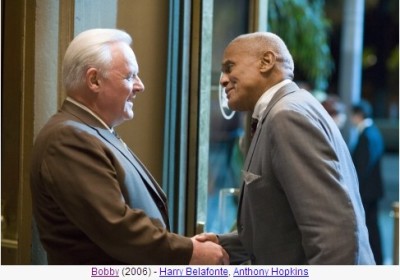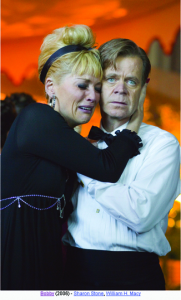By: debbie lynn elias
Over five years in the making, Emilio Estevez gives us his all and brings not only his political passion but his filmmaking passion to the forefront with the already award winning BOBBY. Opening this weekend, BOBBY is an inspirational look at “what if” had Robert F. Kennedy not been assassinated at the Ambassador Hotel in Los Angeles on June 4, 1968. Using the hopes, dreams and aspirations of a cast of 22 fictional central characters, Estevez creates an imaginary look at the 24 hours leading up to the assassination and how the lives of these 22 people not only came to be intertwined because of Kennedy and the events of the day, but how they were each impacted by the assassination. The film is so emotionally charged to the point of evoking a sense of loss, yet again, over Kennedy’s passing.
Concentrating on the day leading up to and night of the assassination of Robert F. Kennedy at the Ambassador Hotel in Los Angeles, this is an ambitious endeavor that revolves around 22 individuals present at the hotel on the final day and in the final hours of Senator Kennedy’s life. As we all know, 1968 was a dramatic and traumatic year of social and political upheaval in our country. From the assassination of Martin Luther King, Jr. to that of Robert Kennedy, the times were volatile and heartbreaking. Interspersing actual newsreel images from the period, Estevez intricately weaves a tapestry of storied lives all drawn together at the Ambassador Hotel on that fateful night in June 1968. Using the technique of expertly crafted and edited narrative vignettes, Estevez creates characters from all walks of life someone for everyone to relate to and something that really demonstrates the vast appeal of Kennedy. Setting the political stage is short lived before the film moves full swing into the fictional stories. From doormen to drunken lounge singers to socialites, starlets and dishwashers, almost every walk of life and ethnicity is represented.

The cast reads like a Who’s Who of Hollywood boasting A, B and C list stars. Sir Anthony Hopkins as retired doorman John Casey is stellar as is Demi Moore as the drunken lounge singer Virgnia Fallon who is appearing at the Ambassador that fateful night. Abusive to her husband, interestingly enough played by former reallife flame, Emilio Estevez, Moore gives a fascinating performance. Not to be overlooked are Sharon Stone, Harry Belafonte, Freddy Rodriguez, Christian Slater, Helen Hunt and Martin Sheen. And as a draw for the younger generation, exemplary performances rise from Lindsay Lohan, Joshua Jackson and Elijah Wood. But the crowning performance comes from William H. Macy as hotel manager Paul Ebbers. Look for Oscar to come knocking at the door of not only William H. Macy, but Demi Moore, among others in this film, come February.
Central to the story is the Ambassador Hotel itself. A character in its own right, the Ambassador was often called “a city within a city.” With everything from a chapel to beauty parlor to a 24 hour diner, the hotel held something for everyman from every walk of life. With a lobby to rival the opulence of the Ritz or a 21st century cruise ship, but with a genteel comfort of a home library, it was just as easy to envision a shoeshine man or a king partaking of the hotel’s lifestyle.

Written by Estevez, you can’t help but note the attention to detail not only as to the characters but the embodiment of Kennedy’s beliefs and principles within the story. From acts of generosity and kindness to Kennedy’s empassioned fight for civil rights and the underprivileged, Estevez creates characters and vignettes that epitomize the struggles of the day. A pivotal example of this is the Mexican busboy Jose who was forced to work a double shift, missing the chance to see the Dodgers and Don Drysdale go for a record. Instead, as fate would have it, this young man would become a part of history and be forever remembered as the face and arms that cradled the fallen Senator.
Speaking to the War, Estevez goes far in the creation of Diane, a young girl who determines to marry a friend just to keep him from going to Viet Nam. Desperate times called for desperate measures and Estevez does a fine job of addressing the issues plaguing our nation at the time – all within the confines of the Ambassador and these 22 characters.
Perhaps the one faux pax was the creation of some junior campaigners who end up on their first LSD trip thanks to hippie pusher Fisher played by none other than Demi Moore’s husband, Ashton Kutcher. Over the top and out of place (although part of the times), this was one scene that should have landed on the cutting room floor.
As if the intertwining of the characters isn’t enough, the real-life connections of the cast are undeniably noticeable. From Martin Sheen and Laurence Fishburn who worked together in “Apocalypse Now” to Estevez and Moore who were not only engaged but worked together on two prior films, to William H. Macy and Heather Graham who co-starred in “Boogie Nights” as well as Emilio Estevez and his father Martin Sheen and husband and wife Ashton Kutcher and Demi Moore, the connections are endless. An amusing correlation is that between Demi Moore and Sharon Stone who, in character, discover they one played strippers in big budget disasters (which they both did in real life).
From the opening montage of 1968 archival newsreels which set the stage with the assassination of Dr. Martin Luther King, Jr., reminders of JFK’s assassination some five years earlier to RFK’s presidential primary campaign footage, from the opening clip, you know what you are about to experience is something special. I was, and still am, awed by the thought and meticulous detail Estevez put into not only the script and its dialogue, but the filming itself. Shot on location at the Ambassador Hotel during its razing, the film embodies history. Impressive to a fault is the work of production designer Patti Podesta who brought the Ambassador back to its original grandeur for filming. And cinematographer Michael Barrett should also grab an Oscar nod for his work. Using a Steadicam for the majority of filming, with a soft widescreen lensing, Barrett and Estevez are able to seamlessly blend current footage with archival, giving a documentary feel to the project.
Particularly impressive is the editing of Richard Chew and never moreso than in the film’s climactic moments. With rapid fire precision, the scenes shift between actual newsreels and the characters all set against a speech delivered by Kennedy following Dr. King’s assassination addressing ways to halt violence in the world. Emotionally charged, your hairs will stand on end and tears will roll down your cheeks.
No matter how much things change, they still stay the same. Almost 40 years later, there is still a cry for civil rights, fights for the underprivileged and calls for ways to end war and violence in the world. With BOBBY, Emilio Estevez reminds us that there was – and still is – hope of better things to come.
Sir Anthony Hopkins: John Casey
William H. Macy: Paul Ebbers
Demi Moore: Virginia Fallon
Emilio Estevez: Tim Fallon
Freddy Rodriguez: Jose
Harry Belafonte: Nelson
Sharon Stone: Miriam
Martin Sheen: Jack
Helen Hunt: Samantha
Laurence Fishburn: Edward Robinson
Written and Directed by Emilio Estevez. Rated PG. (120 min)












